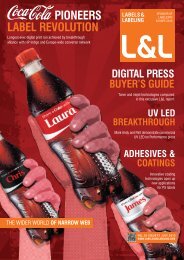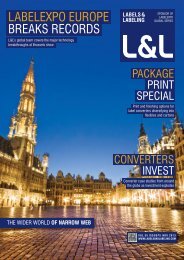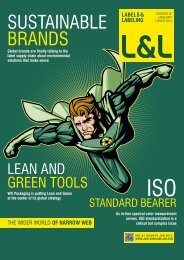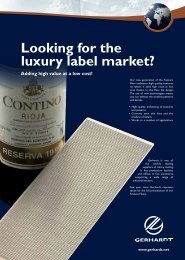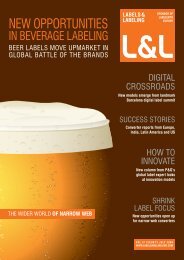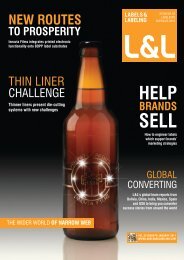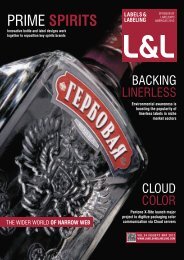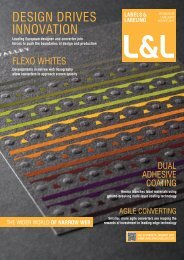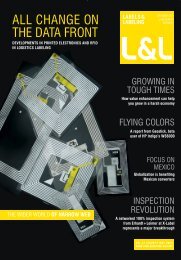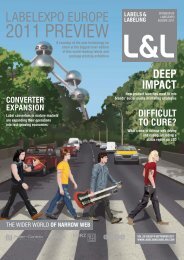You also want an ePaper? Increase the reach of your titles
YUMPU automatically turns print PDFs into web optimized ePapers that Google loves.
96 | L&L<br />
LABELS BOLIVIA is equipped with an 8-color Mark Andy 2200 flexo press ARTES Gráficas Raal installed an HP Indigo ws4050 digital press in 2006<br />
infrastructure and sales presence.<br />
Equipped with the 8-color Mark Andy 2200 flexo press with<br />
reverse printing capability, as well as finishing and digital<br />
photopolymer platemaking equipment, the joint venture – Labels<br />
Bolivia – is now producing high quality labels for pharmaceutical,<br />
cosmetics and security applications – the areas of Raal’s expertise<br />
in Argentina.<br />
‘There is one Chinese character to signify both crisis and<br />
opportunity – it’s a sentiment that was appropriate for our<br />
situation,’ says Gustavo Alterman. ‘We had to move out of Target’s<br />
factory, but it created a great opportunity and it has worked out<br />
for the best. Grupo Ravi is well-known in Bolivia, which helps us to<br />
gain credibility in the local market.’<br />
With few clients shared between Grupo Ravi and Artes<br />
Gráficas Raal, Romina Morgenstein continues to be based in<br />
Cochabamba and a dedicated sales team for Labels Bolivia has<br />
been established. ‘It is important to have a local presence,’ says<br />
Morgenstein, ‘as these are two different companies with different<br />
working cultures. But we are lucky to have found excellent people<br />
to partner with and to work with us in the factory.’<br />
Morgenstein admits to being surprised at the high quality<br />
demands from local brands – reflected in the fact that Labels<br />
Bolivia is mainly producing high quality labels for demanding<br />
applications.<br />
Grupo Ravi’s Sergio Miranda says that the company was not<br />
actively considering a move into the self-adhesive label market<br />
prior to being put in touch with Raal. Grupo Ravi does have a<br />
wet-glue label operation based in the Dominican Republic, called<br />
Labels Caribe, that supplies polypropylene labels to the beverage<br />
industry, but the partnership with Raal represents its first foray<br />
into self-adhesive label production. ‘It was a project in which we<br />
immediately had a great deal of interest,’ says Miranda. ‘It was a<br />
natural step for the development of our business and there is a<br />
great potential for the label market in Bolivia.’<br />
Given Bolivia’s strategic location within South America – it<br />
shares borders with five other countries – there is potential for<br />
export in the near future. First, says Miranda, the company is<br />
focused on establishing Labels Bolivia within its local market, with<br />
export markets likely to be targeted after further investment in<br />
capital equipment to increase production capacity.<br />
Miranda describes the Labels Bolivia project as ‘a top priority’<br />
for Grupo Ravi. At a corporate level, the group is looking on with<br />
interest – seeing potential for this blueprint to be replicated in<br />
other markets in the future.<br />
‘It has been a tremendous advantage to have Raal as a partner,’<br />
he says. ‘It is a company with a great profile in the industry and<br />
a long history of expertise in high quality self-adhesive label<br />
production.<br />
‘But while Raal has of course been a great help to us in making<br />
the transition, Grupo Ravi has a great deal of experience in<br />
moving into new sectors and new countries. It is part of the<br />
LABELS&LABELING<br />
company’s culture, and this too has been an important factor.’<br />
Raal’s Gustavo Alterman echoes the sentiments about<br />
exporting. ‘There is much potential for export, given the<br />
country’s location and its low manufacturing costs, but for<br />
now we are focused on Bolivia. There is also little competition<br />
locally, which is an advantage.’<br />
BUENOS AIRES<br />
Artes Gráficas Raal was founded in 1963 by Gustavo<br />
Alterman’s father and grandfather, Raul Alterman, who lent<br />
the first two letters of each of his names to give the moniker<br />
Raal. It began as a manufacturer of cardboard boxes for shoes<br />
and toys, but when clients began asking for the boxes to be<br />
identifiable, Raal saw the potential for label production.<br />
Self-adhesive labeling was rising in prominence and offered<br />
an easier alternative to glue labeling for this type of application.<br />
Labels could also be delivered more easily, taking up less<br />
space in transit than cardboard boxes. Beginning with simple<br />
labels for school books, Raal installed a 1-color Reprex press<br />
in 1970, followed quickly by a second and then an Ibirama<br />
letterpress machine. Gustavo Alterman remembers, aged 10,<br />
helping out with what was then the company’s biggest order<br />
to date – a run of one million labels for a promotional school<br />
books campaign.<br />
Production continued at the company’s factory in the<br />
Floresta neighborhood of Buenos Aires until 1994, when it<br />
was destroyed by a fire. The company lost a great deal, says<br />
Alterman – equipment, dies, plates, files. The burned-out<br />
remains of a Kopack press, installed just two months<br />
previously, was sold to fellow converter Artes Gráficas<br />
Modernas which was able to coax the machine back into<br />
production, dubbing it the ‘Niki Lauda’ in homage to the<br />
Austrian former Formula One driver who was burned in his car<br />
– but survived – during the 1976 German Grand Prix.<br />
The company moved into a new factory in the Paternal<br />
district of Buenos Aires four months after the fire. In the<br />
intervening period, production was able to continue thanks to<br />
support from family friends – the Ibirama press was installed<br />
at the factory of one friend, while another allowed them to use<br />
his own label printing equipment at night, when production<br />
had finished for the day. Suppliers were paid off thanks to the<br />
company’s cash reserves. ‘Our suppliers still remember that<br />
to this day,’ says Alterman. ‘Not many companies would have<br />
been able to do that.’<br />
Settled in the new 1,500 sqm factory where Raal continues<br />
to operate to this day, investment began. A 6-color Mark Andy<br />
2200 was installed in 1995, equipped with flat-bed die-cutting<br />
that suited Raal’s core work of short runs and later upgraded<br />
with two more color units. A 5-color Gallus T-180 semi-rotary<br />
letterpress machine quickly followed, equipped with hot<br />
stamping, UV varnishing and flat-bed die-cutting, which



